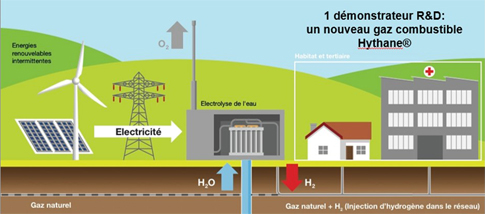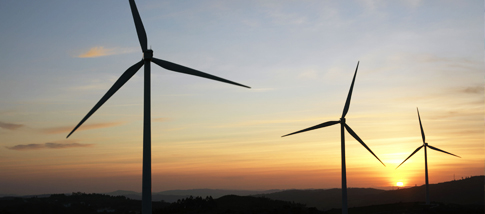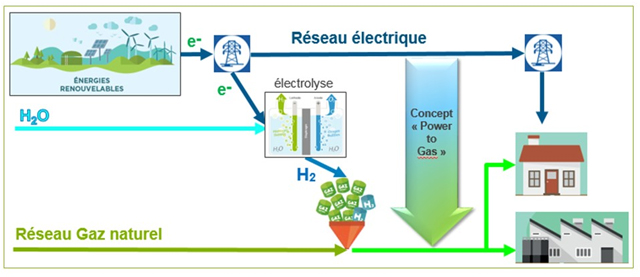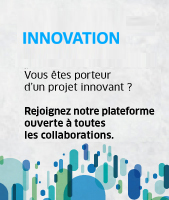Energy from renewable sources offers many benefits. Nevertheless, its intermittent availability complicates the process of balancing supply with demand. Power-to-Gas offers a real solution for power supply system backup going forward.
Power to gas

The GRHYD demonstration project
The GRHYD demonstrator makes it possible to valorize the ENR (green electricity not finding an outlet on the electricity network) in the form of hydrogen gas distributed in the natural gas network, by implementing the Power-to-Gas concept.

The Power-to-Gas principle is based on storing surplus energy from renewable sources by converting it to hydrogen or methane syngas. The existing natural gas pipeline networks can also carry the resulting hydrogen and/or methane, facilitating the storage and transportation of these gases, which can then be blended with natural gas. “Power-to-Gas” exists at the intersection between many different ENGIE areas of expertise in energy and services:
- power generation from renewable sources
- energy management
- energy services
- transportation
- natural gas marketing
This project to promote green electricity will therefore inject a new level of flexibility into the energy supply system through the production of hydrogen, and maximizes the proportion of energy from renewable sources in French energy consumption. Power-to-gas therefore responds effectively to the intermittent availability of energy from renewable sources.
At present, the main applications for hydrogen are industrial, but there is no doubt that over the last 10 years or so, European – and particularly German – initiatives have developed rapidly to the point where hydrogen is becoming a realistic response to the challenges posed by energy supply and climate change. For example, Germany has adopted a strategy for introducing hydrogen-powered vehicles and buildings by 2020, using either internal combustion or fuel cell technologies.
Hydrogen
Hydrogen is regularly cited as the energy source of the future, because it offers an effective response to two of the main energy challenges of the 21st century: the gradual depletion of non-renewable energy sources, and the need to cut greenhouse gas emissions and local sources of pollution. Pollution is effectively eliminated, because hydrogen combustion releases only water.
The key benefit of hydrogen is its ability to generate energy, particularly electricity. For example, hydrogen makes it possible to consider zero-pollution (electric) vehicles with a long range between recharges and a high level of energy efficiency.
The International Energy Agency believes that hydrogen should ‘play a crucial role’ in the global economy, but that its production, storage and transportation require more advanced technological optimization, meaning that its widespread introduction can be realistically envisaged in the period 2025-2030.
Power-to-Gas innovations
- New products and offers: NG-H2 gas distributed via the natural gas pipeline network, Hythane® fuel for vehicles, and VNG vehicles adapted for use with Hythane fuel
- Innovative technologies driven by French companies: electrolyzers, storage technologies, H2 management (arbitrage), production and storage tools
- A solution for the transportation of hydrogen via NG-H2 blending

La technologie du Power-to-Gas permet de stocker plus efficacement les surplus d’électricité renouvelable et de les mettre au service de différents usages : chauffage, eau chaude, mobilité.
L'injection dans les réseaux de gaz facilitera l'intégration des énergies renouvelables intermittentes dans le mix énergétique et permettra d'augmenter leur part dans la consommation énergétique finale. Le potentiel du Power-to-Gas est estimé par l'Ademe à 30 TWh par an pour la France métropolitaine à horizon 2030.
Le « Power to Gas » est au carrefour des métiers d’ENGIE dans le domaine de l’énergie et des services :
- la production d’électricité renouvelable,
- la gestion énergétique,
- les services à l’énergie,
- le transport,
- la commercialisation de gaz naturel.
Les innovations liées au « Power-to-Gas »
- De nouveaux produits et offres : un gaz GN-H2 distribué par le réseau de gaz naturel, un carburant Hythane® pour véhicules, des véhicules GNV adaptés au carburant Hythane® ;
- Des technologies innovantes portées par des acteurs français : électrolyseurs, technologies de stockage, outils de gestion (arbitrage) & pilotage de production & stockage H2 ;
- Une solution d’acheminement de l’hydrogène via le mélange GN-H2.
Chiffres clés
Le Power-to-Gas, c'est :
- A l'horizon 2030, une technologie pleinement opérationnelle en France, sans qu’il n’y ait ni rupture technologique, ni besoin de développer de nouvelles infrastructures de transport.
- A l'horizon 2035 l'Ademe évalue le potentiel d'hydrogène produit à partir d’électricité en France en ayant recours au Power-to-Gas à environ 30 TWh par an.
- En 2050, les installations de Power-to-Gas pourraient également permettre de coproduire entre 5 et 18 TWh de chaleur et entre 3 400 et 11 700 kt d’oxygène.
- En 2050, alors que 50 % de l'énergie en France devrait provenir de ressources renouvelables, le Power-to-Gas permettrait de produire entre 20 et 30 TWh/an de gaz vert injectable dans les réseaux existants.
Source : Étude de l’Ademe portant sur l’hydrogène et la méthanation comme procédé de valorisation de l’électricité excédentaire
